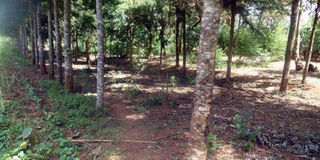Mass grave holds remains of Lari Massacre victims

Eucalyptus trees cordon off a stretch of graves of Mau Mau fighters in Lari. PHOTO | MARION KANARI | NATION MEDIA GROUP
What you need to know:
- For years, the Kanyi wa Mwaura family has welcomed numerous visitors — Mau Mau veterans, government officials, local and international scholars and families who lost their loved ones during the Mau Mau screening exercises.
- Kiambu Governor William Kabogo, while on a visit to the site, called for the release by the British Government of the names of those buried there.
The release of Kenyan freedom fighter Dedan Kimathi’s official court documents by the British Government 59 years after he was executed, and the appeal by his widow Mukami Kimathi to have his remains traced have not only cast a spotlight on the struggle for independence but also the 1953 Lari Massacre.
An alleged 10,995 people were brutally killed in all Mau Mau hideouts and their fingerprints taken before the bodies were dumped in a mass grave in Lari, Kiambu County. The grave sits in Ms Teresia Kanyi wa Mwaura’s three-acre piece of land, occupying an estimated three-quarter-acre stretch.
“They would bring them at night in a lorry and dump them there,” recounts Ms Rachel Njuhi wa Munga, a Mau Mau loyalist who survived the ordeal.
Ms Kanyi’s family does not cultivate the land. Ms Njuhi, the 95-year-old long-time neighbour of Ms Kanyi’s, says the skeletons are buried as shallowly as three feet.
The grave area is condoned off with eucalyptus trees. A slim path tracing the area from Ms Kanyi’s house is noticeable. The 84-year-old Ms Kanyi says she has been taking care of the area since the 1960s.
“Every year I set a date to remember and pray for those fallen heroes,” Ms Kanyi says, staring at the trees. “May they rest in peace.
“I hope the government will put up a memorial site in remembrance of these souls.”
For years, the Kanyi wa Mwaura family has welcomed numerous visitors — Mau Mau veterans, government officials, local and international scholars and families who lost their loved ones during the Mau Mau screening exercises.
“Some families come here to pray,” said Ms Kanyi. “Mau Mau Veterans Association chairman Gitu wa Kahengeri has visited several times.”
A government pathologist is also said to have visited the mass grave once and carted away several bones but has never returned.
The colonisers are alleged to have hidden the actual location of the mass grave. Kiambu Governor William Kabogo, while on a visit to the site, called for the release by the British Government of the names of those buried there.
Although President Uhuru Kenyatta has said he will meet and fete Mau Mau war veterans this month, Mr Kabogo has appealed to the national government to recognise the fallen heroes by building a monument at the site.





